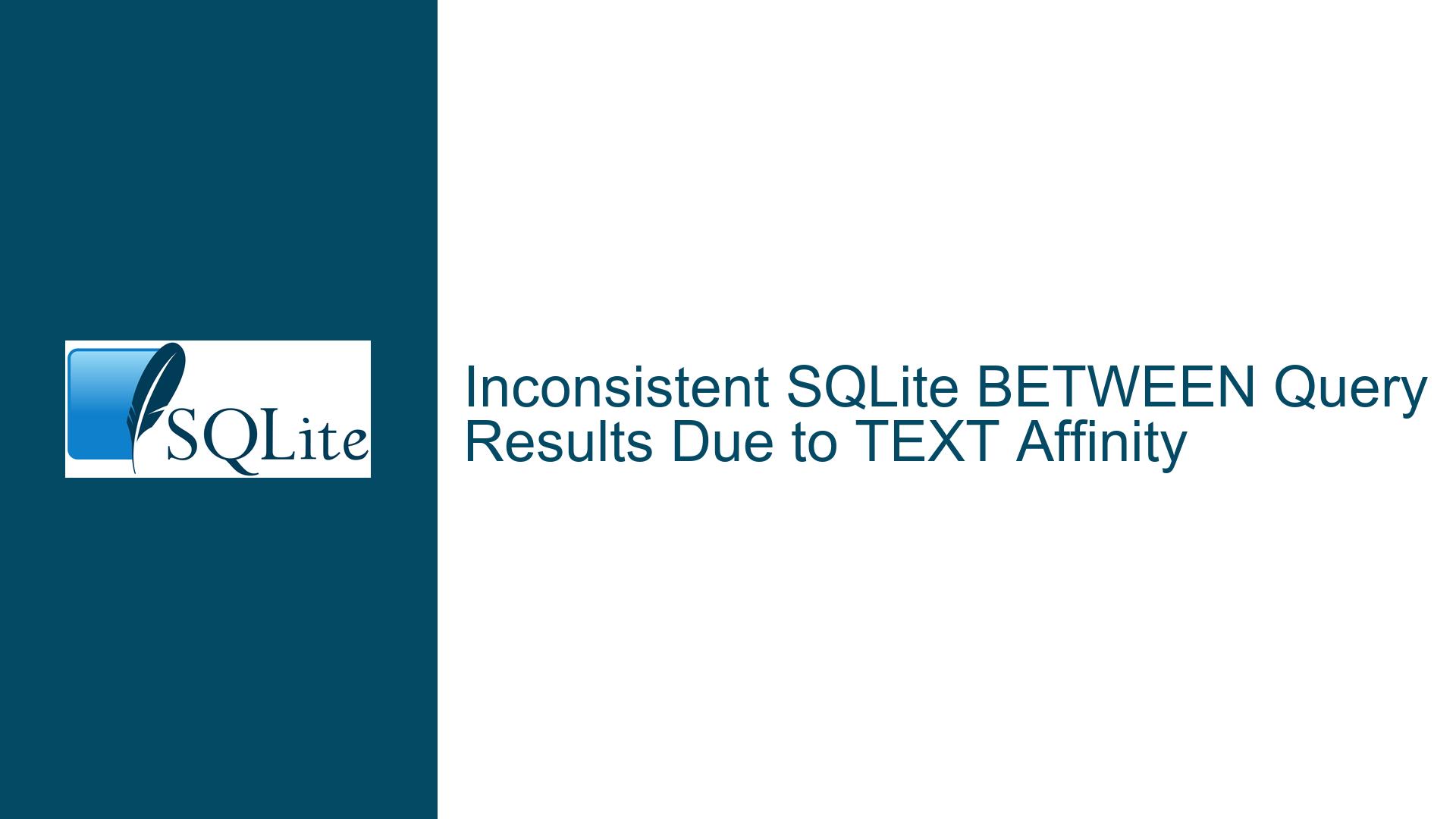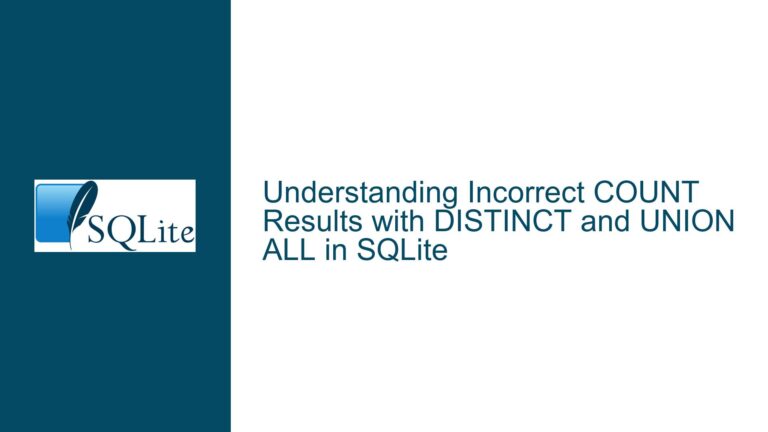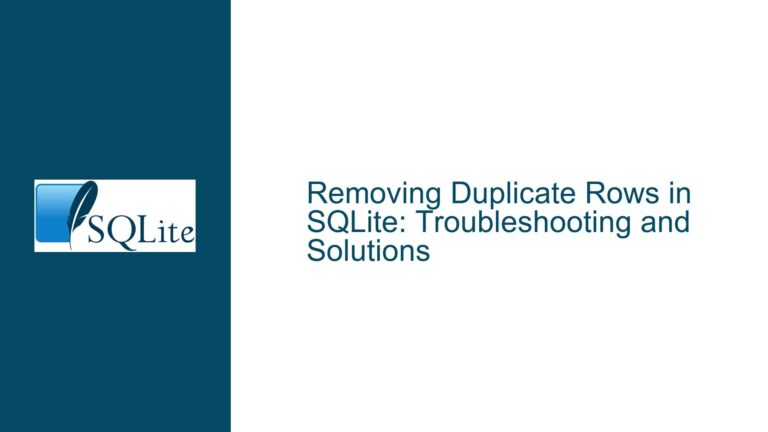Inconsistent SQLite BETWEEN Query Results Due to TEXT Affinity
Issue Overview: TEXT Affinity Causing Lexical Comparison in BETWEEN Queries
The core issue revolves around the unexpected behavior of the BETWEEN operator in SQLite when applied to columns with TEXT affinity. The user is attempting to query a table where col_a and col_b are defined as TEXT, and the query involves checking if a numeric value falls between the values in these columns. However, the query returns inconsistent results because SQLite performs a lexical (string-based) comparison instead of a numeric comparison. This occurs due to SQLite’s type affinity rules, which dictate how values are compared when operands have different affinities.
In the provided example, the table my_table contains two columns, col_a and col_b, which store 13-digit numeric values as TEXT. The user’s query checks if a 12-digit or 13-digit numeric value falls between col_a and col_b. However, because the columns are TEXT, SQLite compares the values lexically rather than numerically. For instance, the string "401111000001" (12 digits) is lexically greater than "4011110000000" (13 digits) because the first 12 characters are identical, and the 13th character in the second string is ‘0’, which is less than ‘1’. This leads to incorrect query results, as the BETWEEN operator evaluates the condition based on string comparison rules rather than numeric rules.
The user’s query is further complicated by the fact that the input value and the column values are of different lengths. When the input value is 12 digits long, it is lexically compared to 13-digit strings in col_a and col_b, leading to unexpected matches. For example, the query SELECT * FROM my_table WHERE 401111000001 BETWEEN col_a AND col_b incorrectly returns the row with ID 1 because "401111000001" is lexically between "4011110000000" and "4011119999999".
Possible Causes: TEXT Affinity and Lexical Comparison in SQLite
The root cause of the issue lies in SQLite’s type affinity system and its handling of comparisons between TEXT and numeric values. SQLite uses a dynamic type system where the type of a value is associated with the value itself, not the column in which it is stored. However, columns have a type affinity that influences how values are stored and compared. When a column has TEXT affinity, all values inserted into that column are treated as TEXT, even if they are numeric.
In the case of the BETWEEN operator, SQLite performs comparisons based on the affinity of the operands. If one operand has TEXT affinity and the other is a numeric literal or has no affinity, SQLite applies TEXT affinity to the other operand. This means that the comparison is performed lexically rather than numerically. For example, in the query SELECT * FROM my_table WHERE 401111000001 BETWEEN col_a AND col_b, the numeric literal 401111000001 is treated as TEXT because col_a and col_b have TEXT affinity. As a result, the comparison is performed as a string comparison, leading to incorrect results.
Another contributing factor is the length discrepancy between the input value and the column values. When the input value is 12 digits long and the column values are 13 digits long, the lexical comparison can produce unexpected results. For example, the string "401111000001" (12 digits) is lexically greater than "4011110000000" (13 digits) because the first 12 characters are identical, and the 13th character in the second string is ‘0’, which is less than ‘1’. This causes the query to incorrectly return rows where the input value is not numerically between col_a and col_b.
Troubleshooting Steps, Solutions & Fixes: Ensuring Numeric Comparison in BETWEEN Queries
To resolve the issue, the user must ensure that the comparison in the BETWEEN query is performed numerically rather than lexically. This can be achieved by explicitly casting the TEXT values in col_a and col_b to INTEGER or REAL before performing the comparison. SQLite supports the CAST function, which can be used to convert values to a specific type. By casting col_a and col_b to INTEGER, the comparison will be performed numerically, producing the correct results.
The corrected query would look like this:
SELECT * FROM my_table WHERE 401111000001 BETWEEN CAST(col_a AS INTEGER) AND CAST(col_b AS INTEGER);
This query ensures that the values in col_a and col_b are treated as integers during the comparison, regardless of their original TEXT affinity. The CAST function converts the TEXT values to integers, allowing the BETWEEN operator to perform a numeric comparison.
However, the user expressed concern about potential overflow when casting large numeric values to INTEGER. SQLite’s INTEGER type can store values up to 8 bytes (64-bit signed integers), which can represent values from -9,223,372,036,854,775,808 to 9,223,372,036,854,775,807. In the provided example, the values in col_a and col_b are 13-digit numbers, which are well within the range of a 64-bit integer. Therefore, casting these values to INTEGER will not cause overflow.
For even larger numeric values that exceed the range of a 64-bit integer, SQLite provides the DECIMAL extension, which can handle arbitrary-precision decimal arithmetic. However, using the DECIMAL extension comes with trade-offs, such as the inability to use indexes for the columns involved in the comparison. If the table is large and performance is a concern, the user can use a combination of REAL columns for indexing and the DECIMAL extension for precise comparisons.
In summary, the key steps to resolve the issue are:
- Use the
CASTfunction to convert TEXT values to INTEGER or REAL before performing the comparison. - Ensure that the numeric values being compared are within the range of the target type (e.g., 64-bit integers for INTEGER).
- For extremely large numeric values, consider using the
DECIMALextension, but be aware of the performance implications.
By following these steps, the user can ensure that the BETWEEN query produces consistent and accurate results based on numeric comparison rather than lexical comparison.






